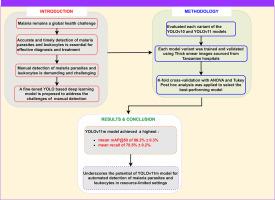用于检测厚涂片图像中的疟疾寄生虫和白细胞的微调基于yolo的深度学习模型:坦桑尼亚案例研究
IF 4.9
引用次数: 0
摘要
疟疾在发展中国家仍然是一个严重的公共卫生问题,准确诊断对有效治疗至关重要。疟疾寄生虫和白细胞的可靠和及时检测对于寄生虫病的精确定量至关重要。然而,手动识别是一项耗费人力、耗时且容易出现诊断错误的工作,特别是在资源有限的环境中。为了解决这一挑战,本文提出了一种微调的深度学习模型,用于检测厚涂片图像中的疟疾寄生虫和白细胞。该模型基于YOLOv10和YOLOv11目标检测架构,每个架构都在从坦桑尼亚医院收集的定制注释数据集上独立训练、验证和评估,以确保上下文相关性。采用五重交叉验证,然后进行统计分析,以确定表现最佳的模型。结果表明,优化后的YOLOv11m模型达到了最高的性能,具有统计学上显著的改进(p <;.001),平均mAP@50为86.2%±0.3%,平均召回率为78.5%±0.2%。这些发现突出了所提出的模型在提高诊断准确性、支持有效的寄生虫病量化以及最终在资源有限的情况下降低疟疾相关死亡率方面的潜力。本文章由计算机程序翻译,如有差异,请以英文原文为准。

Fine-tuned YOLO-based deep learning model for detecting malaria parasites and leukocytes in thick smear images: A Tanzanian case study
Malaria remains a serious public health concern in developing countries, where accurate diagnosis is critical for effective treatment. Reliable and timely detection of malaria parasites and leukocytes is essential for precise parasitemia quantification. However, manual identification is labor-intensive, time-consuming, and prone to diagnostic errors—particularly in resource-limited settings. To address this challenge, this paper proposes a fine-tuned deep learning model for detecting malaria parasites and leukocytes in thick smear images. The model is based on the YOLOv10 and YOLOv11 object detection architectures, each independently trained, validated, and evaluated on a custom-annotated dataset collected from hospitals in Tanzania to ensure contextual relevance. A fivefold cross-validation, followed by statistical analysis, was used to identify the best-performing model. Results demonstrate that the optimized YOLOv11m model achieved the highest performance, with a statistically significant improvement (p < .001), attaining a mean mAP@50 of 86.2 % ± 0.3 % and a mean recall of 78.5 % ± 0.2 %. These findings highlight the potential of the proposed model to enhance diagnostic accuracy, support effective parasitemia quantification, and ultimately reduce malaria-related mortality in resource-limited settings.
求助全文
通过发布文献求助,成功后即可免费获取论文全文。
去求助
来源期刊

Machine learning with applications
Management Science and Operations Research, Artificial Intelligence, Computer Science Applications
自引率
0.00%
发文量
0
审稿时长
98 days
 求助内容:
求助内容: 应助结果提醒方式:
应助结果提醒方式:


